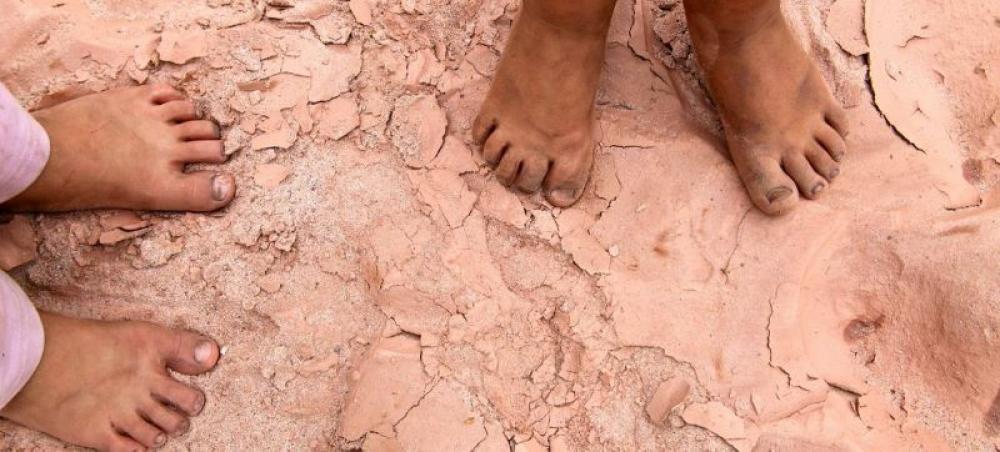Just Earth News | @justearthnews | 09 May 2024, 10:13 pm Print
 Climate Change
Climate Change Two children stand barefoot on cracked, parched soil in a dry riverbed in southern Bolivia. Photo Courtesy: UNICEF/Giacomo Pirozzi
2023 saw another climate record tumble, with Latin America and the Caribbean registering their hottest ever recorded temperatures, according to the UN’s weather monitoring agency.
The World Meteorological Organization (WMO) attributed the temperatures to a “double whammy” of El Niño and long-term climate change, leading to droughts and wildfires combined with extreme rainfall and hurricanes.
“Unfortunately, 2023 was a year of record climatic hazards in Latin America and the Caribbean,” said the agency’s head, Celeste Saulo.
“El Niño conditions during the second half of 2023 contributed to a record warm year and exacerbated many extreme events. This combined with rising temperatures and more frequent and extreme hazards due to human-induced climate change.”
Exceptional and extreme
According to WMO, the 2023 mean temperature was the highest on record, 0.82°C above the 1991–2020 average and 1.39°C above the 1961–1990 baseline.
The year was “exceptional” for Mexico, where temperatures exceeded 45°C, or 113°F, at many weather stations, with a high of 51.4°C (124.5°F) on 29 August. It also experienced the fastest rate of warming in the region.
Extreme heatwaves affected central South America from August to December, with the mercury soaring in parts of Brazil to above 41°C in August. Peru, Bolivia, Paraguay and Argentina all recorded their highest September temperatures. In Uruguay, the 2023 summer was the driest among the last 42 years on record.
Human, wildlife and economic losses
The extreme weather also claimed many lives, along with massive wildlife, ecosystem and economic losses.
The Category 5 Hurricane Otis in Mexico, for instance, resulted in dozens of fatalities and damages costing billions of dollars, while severe droughts disrupted river flow into the Panama Canal, paralysing international shipping.
There were also increased health risks due to exposure to heatwaves, wildfire smoke, sand dust and air pollution, leading to cardiovascular and respiratory problems.
At the same time, record temperatures in the Tefé Lake in the Brazilian Amazon killed over 150 dolphins.
Rising sea levels
WMO also warned of an acceleration in sea level rise.
The mean sea level increased at a higher rate than the global mean in the South Atlantic and the subtropical and tropical North Atlantic Oceans, threatening a large portion of the region’s population living in coastal areas.
Glaciers too faced the climate brunt. The Echaurren Norte glacier in the central Andes mountains – a reference glacier – lost about 31 metres water equivalent from 1975 to 2023.
Source: WMO Droughts in Latin America and the Caribbean region between January and November 2023.
‘No respite in sight’ – Brazil flooding
In related developments, record rainfall over the past few weeks linked to El Niño caused unprecedented flooding in the southern Brazil, affecting over 850,000 people, and resulting in massive infrastructure and economic losses.
According to authorities in the state of Rio Grande do Sul, 78 people have so far been confirmed dead, a further 175 injured and 105 more missing. Almost 19,000 people have lost their homes and about 116,000 displaced.
UN ready to assist: UN chief
In a statement late on Wednesday, UN Secretary-General António Guterres said he was deeply saddened by the loss of lives and damage caused by heavy rains and flooding in Brazil, extending his condolences and solidarity to all affected.
"The United Nations team on the ground stands ready to assist the people of Brazil at this difficult time", the statement continued.
"The Secretary-General notes that disasters such as this are a reminder of the devastating effects of the climate crisis on lives and livelihoods. He reiterates his call for swift international action to curb the chaotic effects of climate change.
“There is no immediate respite in sight,” WMO said in an update issued on Tuesday.
Much of Rio Grande do Sul has been hit by persistent, heavy rainfall since 27 April, according to national meteorological agencies and in some regions, downpours have exceeded 300 millimetres (mm) in less than a week.
In the Southern Brazilian municipality of Bento Gonçalves, for example, the volume reached 543.4 mm.
Call to action
Against the worrying background, WMO called for increased investment and support for climate services, particularly in the health and disaster preparedness sectors, to address the escalating climate-related challenges faced by Latin America and the Caribbean.
It highlighted the need for greater resources for national meteorological and hydrological services to strengthen forecasts and early warnings, and integration of climate data in health surveillance to develop stronger public health response to emerging diseases.
The UN agency also urged adapting the health sector and improved decision making to strengthen resilience against climate change.
- Catastrophe alert: UN warns Asia is facing unprecedented cyclones and rainfall
- Catastrophe alert: UN warns Asia is facing unprecedented cyclones and rainfall
- India’s West Coast Turns Protector: Whale Shark Rescues Surge from Gujarat to Kerala
- Belém COP30 announces major climate finance boost
- Three dead after magnitude 5.7 earthquake hits Bangladesh, strong tremors felt in Kolkata



-1763561110.jpg)


